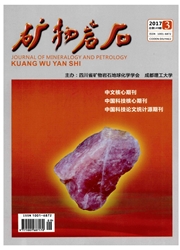

 中文摘要:
中文摘要:
通过对海沟大型中低温热液脉型金矿床与成矿伴生的闪长玢岩(脉)单颗粒锆石CL图像分析和LA-ICP-MSU—Pb年龄测定,获得三组内部组构和年龄时段不同的锆石。其中:第1组锆石发育内部成分环带的同时,具有强烈脆性破裂构造、并在其内部有新生锆石充填,其单点年龄为不谐和年龄,变化区间在2292Ma~1262Ma,计算得上交点为2515Ma±34Ma、下交点为502Ma±110Ma(MSWD=0.59);第Ⅱ组以发育弱成分环带、自形一半自形晶为特征,单点谐和年龄为1925Ma~1720Ma(N=12,Mean=1815Ma±130Ma,MSWD=0.069,MSWD=1.00);第Ⅲ组锆石则以发育清晰内部成分结构、自形为特征,单点谐和年龄为131Ma~122Ma(Mean=128Ma±12Ma,N=3,MSWD=3.2,MSWD=0.041)。从闪长玢岩岩浆作用与区域地壳演化角度分析,第Ⅰ组和第Ⅱ组锆石均为岩浆作用过程捕获的碎屑锆石,而第Ⅲ组锆石则是闪长玢岩岩浆上侵后结晶形成的锆石;依据三组锆石的内部构造特征,结合区域地质演化特征,我们认为强烈缩减的新太古代地壳区可能是海沟金矿床的伴生脉岩和含矿流体产生的热动源区,其动力学背景与中生代库拉板块向中国东部大陆俯冲引发的和龙地体向北侧兴蒙造山带的强烈挤压剪切作用相适应。
 英文摘要:
英文摘要:
Based on the study of CL image and LA-ICP-MS U-Pb dating of single zircon grain from dioritic-porphyrite,associated with the Haigou middle-low temperature hydrothermal veintype gold deposit in Yanbian,Jinin Province, three groups of zircon with different fabrics and ages are observed. In the first group, zircons reveal obvious composition zones and brittle fracture, filled with new zircon grains,and the single age is discordant,ranging from 2 292 Ma to 1 262 Ma and the upper and lower intercept U-Pb ages are 2 515 Ma±34 Ma and 502 Ma±110 Ma (MSWD =0. 59), respectively. The second group zircons are euhedral to subhedral in shape and have weak composition zones,and its single concordant age is from 1 925 Ma to 1 720 Ma ( N=12 , Mean= 1 815 Ma±130 Ma,MSWD= 0. 069,MSWD= 1.00). The third group zircons are euhedral and have clear interior structure,and its single concordant age is from 131 Ma to 122 Ma (Mean= 128 Ma± 12 Ma, N = 3, MSWD = 3.2, MSWD = 0. 041 ). According to the diorite magmatism and crustal evolution, the first and the second groups are detrital zircons captured during magmatism, while the third group zircons are crystallized during dioritic-porphyrite intrusion. Combining with zircon internal structure of these three groups and regional geological evolution, it is proposed that late Archean strongly compression crust may be the dynamothermal source of the formation of the vein rocks associated with the Haigou gold deposit and ore bearing fluids. The geodynamical mechanism is the compression and shearing of Helong terrane towards the north Xingran-Mongolian orogenic belt in Mesozoic.
 同期刊论文项目
同期刊论文项目
 同项目期刊论文
同项目期刊论文
 Timing of formation and geological setting of low-sulphidation epithermal gold deposits in the conti
Timing of formation and geological setting of low-sulphidation epithermal gold deposits in the conti Geology and ages of porphyry and medium- to high-sulphidation epithermal gold deposits of the contin
Geology and ages of porphyry and medium- to high-sulphidation epithermal gold deposits of the contin Re-Os and U-Pb geochronology of porphyry Mo deposits in central Jilin Province: Mo ore-forming stage
Re-Os and U-Pb geochronology of porphyry Mo deposits in central Jilin Province: Mo ore-forming stage Zircon U-Pb-Hf isotopes and bulk-rock geochemistry of gneissic granites in the northern Jiamusi Mass
Zircon U-Pb-Hf isotopes and bulk-rock geochemistry of gneissic granites in the northern Jiamusi Mass Petrogenesis of the Wudaogou intermediate–mafic complex, NW China: zircon U–Pb dating, whole-rock an
Petrogenesis of the Wudaogou intermediate–mafic complex, NW China: zircon U–Pb dating, whole-rock an 期刊信息
期刊信息
